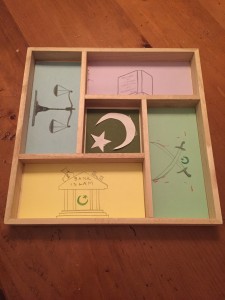The “Framed Pakistan” four framed images surrounding the crescent moon of Islam respectively portray the distinct authorities in Pakistan that manipulated the role of Islam to maximize their own legitimacy. I echo off the perspective of Abbott in “Pakistan and the Secular State” to visually display the divisive role of Islam in the emergence of a nation. The figurative idea of different frameworks existing within society demonstrates how authorities played a hostile role in the development of Muslim identity. For that reason, I take these frameworks in a literal sense for this creative piece. The frameworks of these authorities are literally portrayed in each of the sections surrounding the central force of Islam driving the foundation of the state.
I represent the inflexible frameworks of law, economy, religion, and military authorities in Pakistan, which posed many challenges in the establishment of the Pakistani constitution. Legal authority is depicted with the scale of justice used in the court of law. In this form, authorities try to interpret the Qur’an in a way that maintains social order and benefits the state. Much debate surrounded determining the extent to which Islam (according to the Qur’an) would govern the laws of the nation. Similarly, economic authority, specifically the debate over interest, was another area of conflicting interpretation with the emergence of the Islamic state. I portray the role of Islam in the economy with the image of “Bank Islam” and the payment of the riba. The riba represents how the Qur’an intervened with state affairs. There remains controversy and clashing opinions over the payment of the riba because it is forbidden in the Qur’an. Thus, religious affairs and opposing interpretations of the riba in the Qur’an threaten the financial situation of Pakistan. Additionally, I represent religious authority with the image of the Pakistani constitution. Abbott stresses the negative influence of different religious leaders’ interpretations of what constitutes a Muslim. Religious leaders called for an amendment in the constitution that declared the Ahmadiyya a non-Muslim minority. Ahmadi individuals, therefore, could not take any part in the government or military. This brings me to the last, debatably most important area of authority, which is the military. The military, represented with the crossing swords, neglected any sort of polity and democracy in Pakistan and dominated all affairs of society, while using Islam to maintain control. Overall, these areas of authority embody the theme of how the ‘many Islams’, described in my other creative responses, created issues in the balance between religion and state
